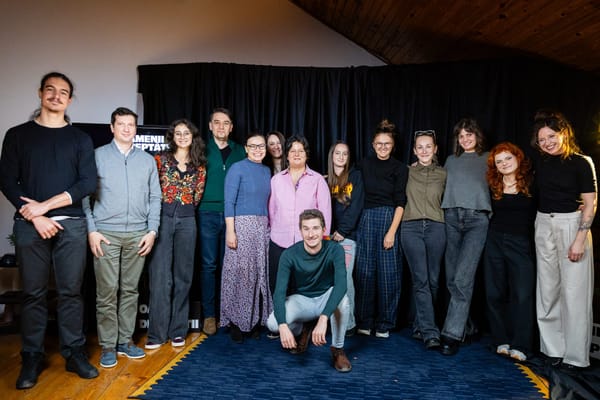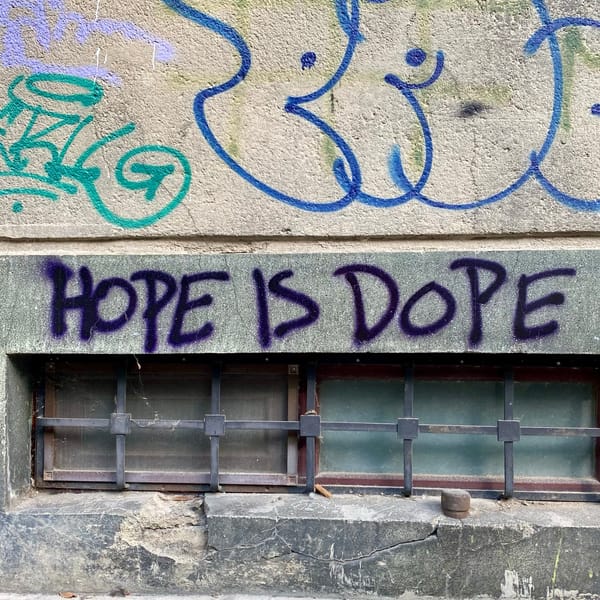Draft Four: People like us. Where are they?
On using stories to create more experiences of togetherness

I want to start by saying thanks for reading my previous letter on the release of our podcast Prea Sărac, and offering deep gratitude to those that donated for it. This remains my ask through the end of the year – if you enjoyed the podcast and want to support our way forward, consider donating.

Recently I posted an Instagram story of DoR’s cover from December 2015. It was black except for a couple of sentences sketched by the artist George Roșu: “We are lonelier / But there are many of us”. It captured both the mourning and the mobilizing anger of that moment, when more than 60 people died and dozens more were injured in a fire in Colectiv, a club in Bucharest.
A few people replied in private: “We’re not that many anymore”.
This rang true.
In the collective grief of that fire, where many of us in the city knew people – some who died, some who were injured – there was a generational WE that said we had enough. It was hard to draw a boundary around the we, but, for some time after that moment, the circle seemed to expand. Sure we can look back now and segment the crowd by class, interests, and what have you – but in those moments that’s not what counted. It was a feeling of strength in belonging, a hope that a broken and corrupt system could be reformed.
That feeling is largely gone, dismantled over years of political disappointments, powerlessness, and fragmentation aided by the pandemic and the ideological polarization fueled by seemingly endless elections over the past year and change.
We’re fragmented. There is less of an us and I believe we’re experiencing this fragmentation as a terrible loss we don’t know what to do with.
Do you feel it, too?
*
I’ve been reading Will Storr’s new book A Story is a Deal, because I am interviewing him in a few days for the launch of the Romanian translation. Storr also wrote the wonderful The Science of Storytelling (available in Romanian, too), where he breaks down the mechanisms and techniques of story. In A Story is a Deal he explains what stories do to the brain and why that matters for business and leadership. As he puts it: “Story is what we do. Story is who we are. Story is human life itself.”
What we do when entering real or fictional story-worlds (the real or imagined universes we live in) is we look at how others overcame obstacles, what we can learn from them, and whether they are people like us that we could get along with.
Storytelling is identity building, it’s connection with people like us, it’s status assurance, it’s a matter of survival. Writes Storr:
“It’s our powerful and often subconscious need for connection and status that drives us to partially construct our identity out of products that tell a story of who we are; our political, artistic, cultural, hobby, lifestyle and work choices serve the same purpose. This story of self connects us to likeminded people, with whom we collaborate in a shared reality, seeking status from one another. Fusing story-world in this way can leave us profoundly altered. It can change who we are, what we want, what we believe and how we behave.”
When this merging of self and others happens it’s magical. You’ve felt this – at that amazing concert you went to, at a play where everyone is breathless at the end, at a protest.
I have found less and less places where this feeling of belonging to a common WE is accessible.
Partly, it’s because we’re lonelier – all studies show that.
Partly, it’s a lingering aftermath of the pandemic where some of our natural instinct of togetherness has been chipped away.
Partly, it’s the fake togetherness of social media, which does the opposite of what I’m talking about. Of course we’ve always derived status and identity benefits also by what we don’t like and who we are not. But nowadays, the negative identifier has become the internet discourse norm. We post on social media to disconnect.
Unconsciously, we post to connect with those who have the same dislikes – of a policy, of a people, of a cultural artifact. In short, we’re going for connection through hot takes. Here’s the problem with that – you can’t create lasting community and togetherness for too long based on mutual dislikes, and no shared vision of a better future. That’s by nature a threatening environment. Who’ll feel safe if any day they can be next? That is a vulnerable WE, and it will crumble.
So here we are – many of us, scattered over islands and bubbles, and reaching across seems hard.
*
I confess: I have felt a profound sense of loneliness for the past few years. Struggling to define the communities I belong to. Being an introvert also means my need for safety is greater, and Bucharest’s cultural and media tribes feel anything but, with gossip and envy as their glue.
Part of how I fight against my urge to pull back is by trying to create things that are not cynical but built with care and the intention to hold space for “people like us”, whichever that us might be in a particular context. The most complex of these is The Power of Storytelling – last year we closed on a dance party in the dark, which worked precisely because people felt it was their place. (BTW, theme and first speaker announcement coming soon!)
But I also want to tell you about something smaller and soul-enriching we just organized.

With my colleagues at Media DoR – alongside whom we released the podcast – we organized a half-day under the guidance of jesikah maria ross, whose work sits at the intersection of journalism, community organizing, and the arts. jesikah has been doing similar gatherings for many years – in newsrooms as an engagement editor, or with civic actors. In California she gathered people in story circles and others similar formats to talk about the aftermath of sexual assault, housing crisis, and hope as a sustaining force in dark times.
jesikah travelled from the US to run a Story Circle in our office, which is mostly what it sounds like: a circle of 10-12 people that get together to share a story from their life. Or, to get more technical about it, and here I am quoting from jesikah: “Story Circles are intimate gatherings where participants tell stories from their own experience focusing on a common theme. As each person shares a story, a larger, richer and more complex narrative emerges. By the end, people see both real differences and commonalities in their stories. They feel heard, connected, and respected – often across divides. The experience generates new perspectives and greater motivation to make change.”
We prepared the experience carefully: flowers, music, good food, and jesikah’s amazing and calm facilitation. We chose precarity as a theme. And then what happened is that we laughed, we cried, and something special emerged –the feeling of a collective who experienced a powerful moment together, and who’d like to pass it forward in a way.
*
There are the more spontaneous WEs that emerge in large crowds, but there are also constructed ones – this one was –, and I believe we need more of the latter. Part of the fragmentation and distrust we feel is because of disconnection. Part of the disconnection is because not enough people put in the effort to tell stories or create stories that bring us together to build rather than tear down.
This is true for families, teams, large groups, events of all kinds – these days we are so preoccupied with division, being right, and meeting our own personal needs first that we discount our need for collective belonging. Basically, we give in to our tendency for negativity and we fight.
I don’t think all is lost. I see more and more people that intentionally or unconsciously shape the kinds of collective experiences we crave – you can see it in the growth of book clubs, running clubs, dinner initiatives. All of these have bloomed in the past couple of years in Bucharest (and beyond), and sure, the cynic in me might say it’s just a trend or that some people are just chasing clout and money, but there is an identity building and maintaining function they serve.
They affirm people’s story of living in the city, the identity of a reader or runner, they create a sense of belonging among the noise and fragmentation.
As I’ve wrote in this paper last year, journalism can create connection with intention, not just as a byproduct. It can do this in live shows large and small, in story circles, in community gatherings. It can create and hold a space and let something grow that is meaningful for people. A space where they feel seen, and cared for, and listened to.
These are very unsharpened thoughts, so I would love to hear more from you as I continue to explore these ideas: what speaks to you? Where do you find you belong these days? Who creates a WE you are thankful for? What am I not seeing or not taking considerations?
SIDE DISHES:
- jesika has a whole handbook on how to put together Story Circles; downloading is available here.
- For that special feeling of belonging next to hundreds of people, come and see Oamenii Dreptății on November 15 – it’s a live storytelling show that will restore some of your faith in humanity. (I wrote this about last year’s edition, which I co-produced). Get a friend and get tickets today.
- My conversation with Will Storr is Thursday in Bucharest, at Cărturești. You can sign up here.
- The story we did on Colectiv 10 years ago won a European Press Prize special award. It’s a reconstruction of that night through the perspective of numerous people that were there that night.
- A friend launched a Substack covering the news in Hungary as the country tries to build a collective WE to topple the Orban regime in the elections next year.
- This album by Geese, Getting Killed, made me wish to be in the audience to listen to them do this live.




